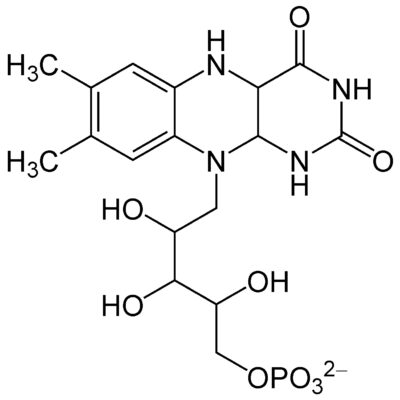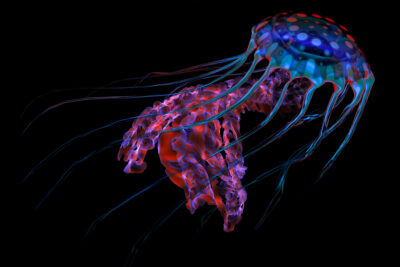 Bioluminescence (pictured left) has fueled folklore legends for thousands of years. From the eighth-century Japanese Hotaru firefly legend to the Apache Indian firefly origin of fire celebration, the origin of bioluminescence continues to inspire awe and wonder.
Bioluminescence (pictured left) has fueled folklore legends for thousands of years. From the eighth-century Japanese Hotaru firefly legend to the Apache Indian firefly origin of fire celebration, the origin of bioluminescence continues to inspire awe and wonder.
Describing myths and legends with a natural explanation is what drives scientists. “Researchers have long wondered how bioluminescence came to be,” science writer Steph Yin noted in the article “In the Deep, Clues to How Life Makes Light,” published in Quanta Magazine.
Matthew Davis, an evolutionary biologist at St. Cloud State University, Minnesota, investigated the origin of bioluminescence across ray-finned fishes using new genetic evidence. Published in PLoS One (2016) and entitled “Repeated and Widespread Evolution of Bioluminescence in Marine Fishes,” Davis explains –
“Our objectives in this study were to determine the number of independent evolutionary origins of bioluminescence in ray-finned fishes.”
Marine Phenomenon
Bioluminescence is primarily a marine phenomenon, as Davis explains –
“At present, the only known terrestrial animals capable of bioluminescence are arthropods (e.g., fireflies, millipedes), whereas, in marine environments, bioluminescence has evolved across the tree of life from bacteria to vertebrates.”
Evidence for the origin of bioluminescence in previous studies has validated Charles Darwin’s natural selection theory developed in The Origin of Species; as Davis explains –
“Broad studies of bioluminescence have typically counted fishes as a single evolutionary event.”
The genomic revolution, however, continues to challenge Darwin’s common ancestry theory. New genetic evidence suggests that there may be multiple rather than a single common ancestor. Davis explains –
“Here, we show that bioluminescence has evolved repeatedly and is phylogenetically widespread across ray-finned fishes.”
Early Bioluminescence Studies
Irishman Robert Boyle (1627–1691) (pictured below) was one of the early scientists to study the phenomenon of bioluminescence. As a founding member of the Royal Society, Boyle discovered the relationship between air and luminescence. Boyle is best known for discovering the pressure-volume gas law known as Boyle’s Law.
The wonder of bioluminescence captivated Charles Darwin. In December 1833, as the HMS Beagle traveled south from Patagonia, Darwin described the phosphorous “spectacle” in the Voyage of the Beagle –
“While sailing in these latitudes on one very dark night, the sea presented a wonderful and most beautiful spectacle…. The vessel drove before her bows two billows of liquid phosphorous.”
More than a century following Boyle’s discovery, a French pharmacologist, Raphael Dubois (1849-1929) (pictured right), was the first to identify luciferin and luciferase, two critical molecular components of bioluminescence. Dubois’ discovery differentiated bioluminescence from phosphorescence.
Since then, the group of small light-emitting protein molecules, known as luciferins, has been found widely among animals, especially in the open sea. Bioluminescence is the molecular light-emitting process of a living organism.
Molecular Bioluminescence
Luciferin, luciferase, and molecular oxygen are the critical reacting molecules producing bioluminescence – the release of light energy is the product of an enzyme-catalyzed chemical reaction. Luciferin is the substrate, and luciferase is the enzyme catalyzing and accelerating the chemical reaction.
Luciferase, an oxidoreductase enzyme, transfers an electron from oxygen, resulting in the emission of light, a visible photon, and the formation of oxyluciferin. This chemiluminescence reaction, also known as bioluminescence, requires a species-specific cofactor to facilitate this enzymatic reaction. The wavelength of the emitted light is species-specific.
Luciferin-associated bioluminescence is a global phenomenon that occurs in all major biological groups. Although the worldwide number of species is unknown, seventy-five known bioluminescent species exist in the Fungi Kingdom alone.
The Davis Findings
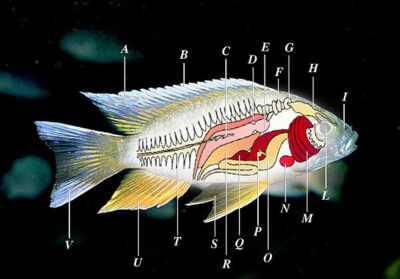 The ray-finned fishes, known as Actinopterygii (pictured right) that Davis studied, are Earth’s largest class of fishes, representing the broadest range of bioluminescent species in nature. Numerically, actinopterygians dominate the class of vertebrates, comprising nearly 99% of the over 30,000 fish species. The ray-finned fish is nature’s ideal candidate for studying the origin of bioluminescence.
The ray-finned fishes, known as Actinopterygii (pictured right) that Davis studied, are Earth’s largest class of fishes, representing the broadest range of bioluminescent species in nature. Numerically, actinopterygians dominate the class of vertebrates, comprising nearly 99% of the over 30,000 fish species. The ray-finned fish is nature’s ideal candidate for studying the origin of bioluminescence.
Unlike Darwin’s common ancestry theory, Davis’ team found evidence of twenty-seven ancestors associated with the origin of bioluminescence, noting –
“27 independent evolutionary events of bioluminescence are identified.”
“Our findings demonstrate that the number of independent evolutionary events [origins] of bioluminescence across the tree of life is significantly higher than previous summaries suggest,” Davis explains.
 Steven Haddock (pictured left), a marine biologist at the Monterey Bay Aquarium Research Institute, found evidence to support even more evolutionary events. In his 2010 paper entitled “Bioluminescence in the Sea,” Haddock explains –
Steven Haddock (pictured left), a marine biologist at the Monterey Bay Aquarium Research Institute, found evidence to support even more evolutionary events. In his 2010 paper entitled “Bioluminescence in the Sea,” Haddock explains –
“It is difficult to calculate the number of times that bioluminescence has evolved independently… bioluminescence has evolved a minimum of 40 times, and likely more than 50 times, among extant organisms.”
As the number of origins increases, untangling the origin of the bioluminescence puzzle is challenged to validate Darwin’s common ancestor theory scientifically. Darwin predicted only a single common ancestor. Davis explains the dilemma –
“It is still unclear how most fishes with intrinsic bioluminescence obtain the necessary substrates to produce light… Our findings… highlight how much remains to be discovered.”
Molecular Diversity 
Luciferin is a diverse species-specific class of small molecules. The number and types of luciferin molecules in nature are not known. Since luciferins are a diverse class of molecules, a unifying molecular mechanism of action has yet to be discovered, except that each mechanism requires molecular oxygen.
Luciferin’s diversity has no known “slight successive” evolutionary changes, as Darwin predicted. Two examples of luciferin molecules are pictured (right and left). Likewise, the relationship between luciferin and luciferase is diverse. As Yin points out –
“Curiously, there are far fewer luciferins than luciferases.”
 Even though luciferin molecules are species-specific, curiously, luciferase molecules are not species-specific. The molecular diversity of luciferase defies categorization based on structure.
Even though luciferin molecules are species-specific, curiously, luciferase molecules are not species-specific. The molecular diversity of luciferase defies categorization based on structure.
The molecular and metabolic diversity of the luciferins challenges their sequencing into the steps of evolution. Without sequential changes, determining their origin is speculation, not science. Haddock concludes –
“Of the two principal components [luciferin and luciferase]… because the complete biosynthesis pathway is not yet known for any marine luciferins, their ultimate origins remain unknown.”
The lack of evidence for luciferin “slight, successive” molecular changes originating from a common ancestor undermines the theory of evolution that Darwin argued in The Origin of Species.
Luciferin-Like Molecules
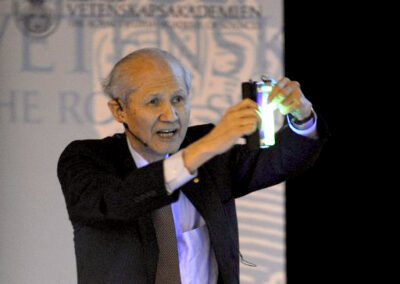 New biomolecular methodologies and technologies opened innovative investigative avenues by the late twentieth century. Osamu Shimamura (pictured right) and Frank Johnson at Princeton University discovered uniformity in bioluminescent molecules across a broad spectrum of species.
New biomolecular methodologies and technologies opened innovative investigative avenues by the late twentieth century. Osamu Shimamura (pictured right) and Frank Johnson at Princeton University discovered uniformity in bioluminescent molecules across a broad spectrum of species.
Shimamura performed the study by measuring light emission using a photomultiplier. Since uniformity is not characteristic of the luciferins, they realized they had discovered a reportable new finding.
Entitled the “Chemical nature of bioluminescence systems in coelenterates,” their 1975 report published in the Proceedings of the National Academy of Science concluded –
“Analysis of substances involved in light-emitting reactions among bioluminescent coelenterates
has revealed a pronounced uniformity in the structural features of initial reactants, i.e., “luciferins” and photoprotein chromophores, as well as the light-emitter product.”
The search for the origin of bioluminescence with uniform luciferin-like molecules, along with diverse luciferin molecules, is a challenging task.
Coelenterate Molecule
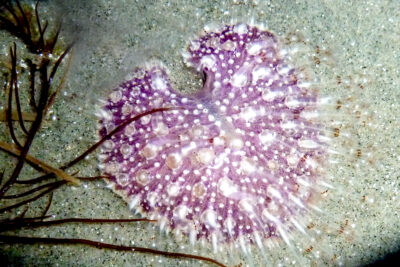 Shimamura’s study focused on the chemical luminescent reactions in the coelenterate phylum.
Shimamura’s study focused on the chemical luminescent reactions in the coelenterate phylum.
Called Cnidarian, this phylum includes more than 9,000 living species, including coral animals, true jellies, sea anemones, sea pens, and comb jellies.
The species in this phylum do not have a circulatory system, relying instead on diffusion across the tissue layers. One coelenterate, Renilla reinformis (pictured left), commonly known as a Sea Pansy (pictured left), is noted for its spectacular display of bioluminescence.
One of the critical emerging key molecular biology technologies during the mid-twentieth century was mass spectrometry (MS). Once extremely expensive, MS equipment became increasingly commercially available.  Previous molecular structure presuppositions, like Shimamura’s, could finally be validated scientifically.
Previous molecular structure presuppositions, like Shimamura’s, could finally be validated scientifically.
Using mass spectrometry (MS) analysis, the Milton J. Cormier team at the University of Georgia published their report two years later in 1977, entitled “Structure of native Renilla reinformis luciferin,” confirming Shimamura’s findings –
“Detailed analysis of kinetic, emission, and quantum yield data for the isolated and synthetic luciferins confirms this structure. Confirmation of this structure in several species from different phyla suggests a common substrate for a variety of bioluminescent marine organisms.”
Cormier validated Shimamura’s luciferin-like molecule – a Coelenterate Molecule. While Cormier described the molecule as “a common substrate for a variety of bioluminescent marine organisms,” Shimamura described the molecule as having “a pronounced uniformity in the structural features of initial reactants.”
The luciferin type and the luciferin-like molecule both produce bioluminescence. Since the luciferin-like molecule is of the coelenterate phylum, sometimes the molecule is called coelenterazine. Does this solve the origin of the bioluminescence dilemma? Yin explains –
“Yet, it would be a mistake to assume that all coelenterazine-containing organisms had evolved from a single luminous ancestor.”
In recognition of his revolutionary finding, Osamu Shimamura received a Nobel Prize in 2008.
Origin of Bioluminescence
In a phylogenetic approach, Davis investigated the evolution and distribution of bioluminescence across ray-finned fishes.
Using a collection of genetic material and with previously reported genetic information, Davis used computer modeling of molecular evolution, specifically the JMODELTEST program. The program uses a set of 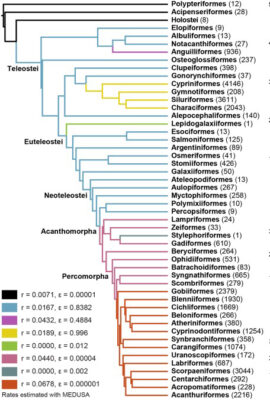 Algorithms to estimate the maximum likelihood of a phylogeny.
Algorithms to estimate the maximum likelihood of a phylogeny.
Of the five models generated by JMODELTEST, the tree with the maximum likelihood was analyzed further by BEAST. The program analyzes molecular sequences. Of the 45,000 trees, the program was subsampled down to 5,000 trees. The computer-generated phylogenetic tree is pictured to the right. According to Davis –
“27 independent evolutionary events [origins] of bioluminescence are identified.”
Twenty-seven origins are incompatible with Darwin’s concept of common ancestry; Davis did not discover the origin of bioluminescence. Finding evidence to support Darwin’s common ancestor theory has proved very complicated. According to Davis –
“Our findings, and these additional studies investigating the evolution and function of bioluminescence and biofluorescence in marine systems, highlight how much remains to be discovered.”
Eugene Koonin Royal Society Interview
 Eugene Koonin (pictured running), head of the Evolutionary Genomics Group at the National Center for Biotechnology Information at the National Institute of Health, was interviewed by science journalist Suzan Mazur, published by The Huffington Post. Regarding the inconclusive evolution referendum at the Royal Society meeting in November, Mazur asked –
Eugene Koonin (pictured running), head of the Evolutionary Genomics Group at the National Center for Biotechnology Information at the National Institute of Health, was interviewed by science journalist Suzan Mazur, published by The Huffington Post. Regarding the inconclusive evolution referendum at the Royal Society meeting in November, Mazur asked –
“Why is it so difficult to pull together the most compelling ideas in evolutionary biology and come up with an approximate understanding of how it all works?”
Koonin answered –
“First of all, I think the public may not have much to lose in terms of confidence in the scientific establishment in this case because the public is already extremely skeptical about the value and the scientific nature of evolutionary biology. It’s not quite that way about science in general, but I think largely so when it comes to the study of evolution.”
Darwin’s dilemma continues.
Genesis
Luciferin is from the Latin word lucifer, meaning “light-bringer.” The biblical account of “Lucifer” means “the morning star.” The burst of the bioluminescence phenomenon is reminiscent of Stephen J Gould’s “punctuated equilibrium” theory to explain the fossil record.
In the search for the origin of bioluminescence, the evidence is compatible with the Genesis account written by Moses.
Robert Boyle (1791-1867) (pictured right), the founder of modern bioluminescence and chemistry, gives a scientist’s perspective during the Scientific Revolution –
“In the Bible, the ignorant may learn all requisite knowledge, and the most knowing may learn to discern their ignorance.”
Evidence from molecular biology to validate the theory of evolution scientifically remains speculative.
Origin of Bioluminescence is a Molecular Biology article.
Darwin Then and Now is an educational resource on the intersection of evolution and science, highlighting the ongoing challenges to the theory of evolution.
Move On
Explore how to understand twenty-first-century concepts of evolution further using the following links –
-
- The Understanding Evolution category showcases how varying historical study approaches to evolution have led to varying conclusions. Subcategories include –
- Studying Evolution explains how key evolution terms and concepts have changed since the 1958 publication of The Origin of Species.
- What is Science explains Charles Darwin’s approach to science and how modern science approaches can be applied for different investigative purposes.
- Evolution and Science feature study articles on how scientific evidence influences the current understanding of evolution.
- Theory and Consensus feature articles on the historical timelines of the theory and Natural Selection.
- The Biography of Charles Darwin category showcases relevant aspects of his life.
- The Glossary defines terms used in studying the theory of biological evolution.
- The Understanding Evolution category showcases how varying historical study approaches to evolution have led to varying conclusions. Subcategories include –
2020 Update
A natural explanation for the origin of bioluminescence continues beyond the reach of science, undermining Darwin’s theory of common ancestry. Since 2016, however, scientists have continued the search – as listed below.
2019 Report
Aubin Fleiss and Karen S Sarkisyan, both of Imperial College London, in their report entitled “A brief review of bioluminescent systems (2019)” published in Current Genetics
“Despite being widely used in reporter technologies, bioluminescent systems are largely understudied. Of at least forty different bioluminescent systems thought to exist in nature, molecular components of only seven light-emitting reactions are known, and the full biochemical pathway leading to light emission is only understood for two of them.”
Current information on the origin of bioluminescence, as posted on WIKIPEDIA, Evolution 101, and the Smithsonian Institute, is listed below.
Luciferin Page
“Evolution” section not included, except for the following statements –
“The variety of luciferins and luciferases, their diverse reaction mechanisms, and the scattered phylogenetic distribution indicate that many of them have arisen independently in the course of evolution.”
“Given the unrelated family of proteins and enzymes to produce bioluminescence, no unifying mechanism of action is known.”
A “tree of life” diagram based on luciferin is not available.
The origin of bioluminescence or common ancestry was not presented.
Bioluminescence Page
The “Evolution” section states –
“All bioluminescent organisms have in common that the reaction of a “luciferin” and oxygen is catalyzed by a luciferase to produce light.”
A “tree of life” diagram based on bioluminescence is not available.
The origin of bioluminescence or common ancestry was not presented.
Luciferase Page
“Evolution” or “Evolve” does not appear on the page.
The origin of bioluminescence or common ancestry was not presented.
Evolution 101 – the site does not include any information on bioluminescence and evolution.
Smithsonian Institute – Smithsonian Ocean page
Evolution/Evolve is mentioned three times regarding bioluminescence
“The number of species that bioluminescence and the variations in the chemical reactions that produce light are evidence that bioluminescence has evolved many times over—at least 40 separate times! This number continues to grow as new research discoveries are made. In 2018, scientists discovered the ray-finned fishes themselves evolved bioluminescence 27 separate times. That’s quite an increase from the handful of times that were known before.”
“However, some animals evolved to emit and see red light, including the dragonfish (Malacosteus). By creating their own red light in the deep sea, they are able to see red-colored prey, as well as communicate and even show prey to other dragonfish, while other unsuspecting animals cannot see their red lights as a warning to flee.”
The Smithsonian does not address the common ancestry or the origin of bioluminescence.

